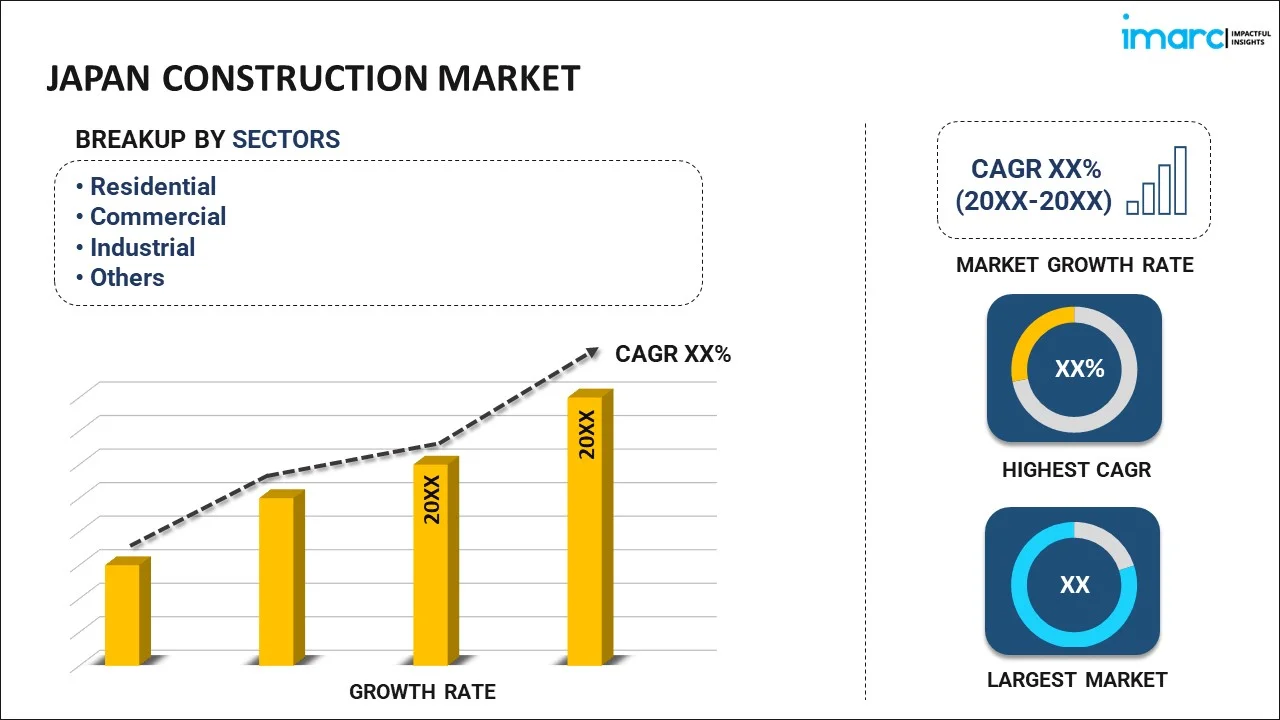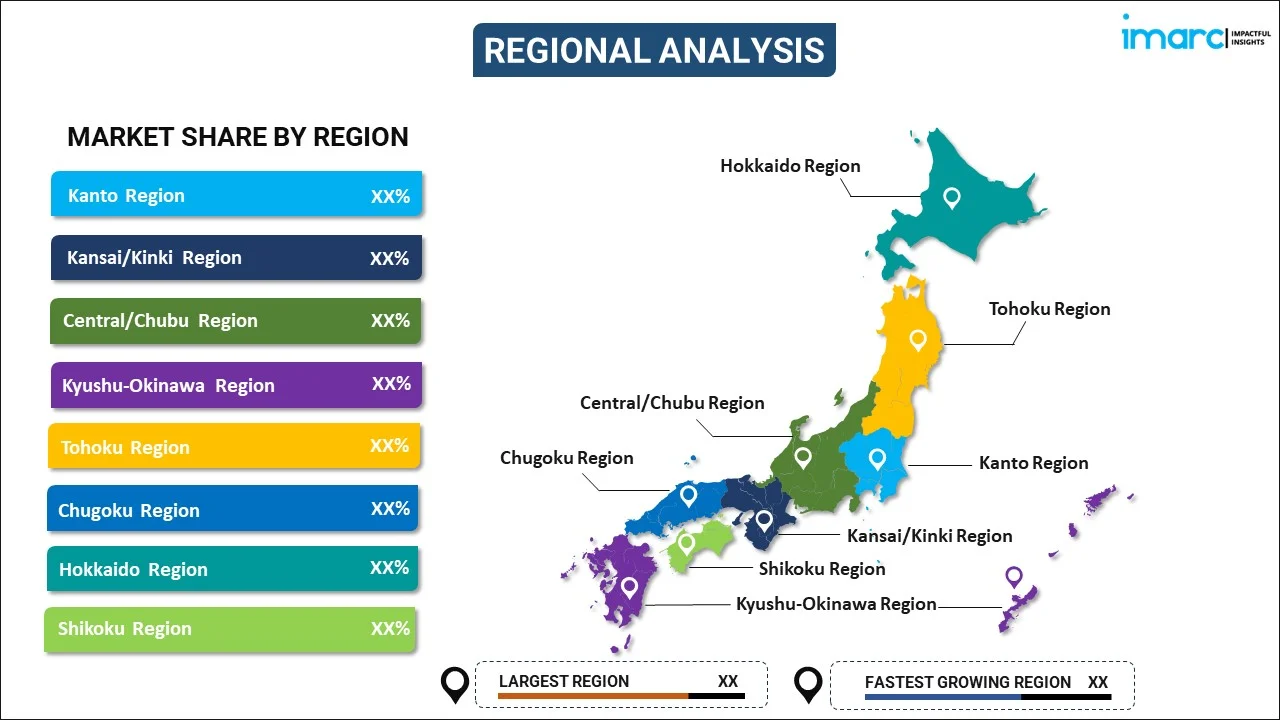
Japan Construction Market Report by Sector (Residential, Commercial, Industrial, Infrastructure (Transportation), Energy and Utilities), and Region 2026-2034
Market Overview:
Japan construction market size reached USD 652.7 Billion in 2025. Looking forward, IMARC Group expects the market to reach USD 941.3 Billion by 2034, exhibiting a growth rate (CAGR) of 4.15% during 2026-2034. The rising adoption of novel technologies, such as data analytics and building information modeling (BIM), which facilitate better planning, visualization, and coordination is primarily driving the market growth.
|
Report Attribute
|
Key Statistics
|
|---|---|
|
Base Year
|
2025 |
|
Forecast Years
|
2026-2034 |
|
Historical Years
|
2020-2025
|
| Market Size in 2025 | USD 652.7 Billion |
| Market Forecast in 2034 | USD 941.3 Billion |
| Market Growth Rate (2026-2034) | 4.15% |
Construction refers to the process of making physical structures or buildings through the assembly and arrangement of materials, labor, and equipment. It encompasses a varied range of activities, from designing and planning to excavation, foundation work, framing, and finishing. Construction projects can vary in scale, complexity, and purpose, ranging from small residential homes to massive infrastructure developments. Key stages in construction include site preparation, where the land is cleared and leveled, followed by the laying of foundations, which provide structural support. Then, structural components like walls, floors, and roofs are erected, and systems such as plumbing, electrical, and HVAC are installed. The project concludes with interior and exterior finishes, ensuring functionality and aesthetics. Construction requires collaboration among architects, engineers, contractors, and skilled laborers to ensure safety, quality, and adherence to building codes. Modern construction practices incorporate sustainable materials and techniques to minimize environmental impact.
Japan Construction Market Trends:
The construction market in Japan is driven by a confluence of factors, primarily the escalating regional population and urbanization trends, necessitating extensive infrastructure development and housing projects. Additionally, economic growth and increased government spending on infrastructure play pivotal roles in propelling construction activities. Furthermore, advancements in construction technologies are enabling the development of more durable and sustainable structures, stimulating market growth by catering to the rising demand for green buildings. The surge in real estate investments is another significant driver fueled by the appealing and stable returns that real estate offers. Moreover, the growing focus on infrastructure development as a means to stimulate economic activity is also a notable driver, with many governments allocating substantial funds for public infrastructure projects. Apart from this, the rise in disposable incomes and changing lifestyles are accentuating the demand for high-quality residential and commercial spaces. Additionally, the widespread adoption of robotics and automation to perform numerous repetitive tasks is expected to drive the construction market in Japan.
Japan Construction Market Segmentation:
IMARC Group provides an analysis of the key trends in each segment of the market, along with forecasts at the country level for 2026-2034. Our report has categorized the market based on sector.
Sector Insights:

- Residential
- Commercial
- Industrial
- Infrastructure (Transportation)
- Energy and Utilities
The report has provided a detailed breakup and analysis of the market based on the sector. This includes residential, commercial, industrial, infrastructure (transportation), and energy and utilities.
Regional Insights:

- Kanto Region
- Kansai/Kinki Region
- Central/ Chubu Region
- Kyushu-Okinawa Region
- Tohoku Region
- Chugoku Region
- Hokkaido Region
- Shikoku Region
The report has also provided a comprehensive analysis of all the major regional markets, which include Kanto Region, Kansai/Kinki Region, Central/ Chubu Region, Kyushu-Okinawa Region, Tohoku Region, Chugoku Region, Hokkaido Region, and Shikoku Region.
Competitive Landscape:
The market research report has also provided a comprehensive analysis of the competitive landscape. Competitive analysis such as market structure, key player positioning, top winning strategies, competitive dashboard, and company evaluation quadrant has been covered in the report. Also, detailed profiles of all major companies have been provided. Some of the key players include:
- Kajima Corporation
- Mori Building Company Limited
- Nippon Concrete Industries Co. Ltd.
- Obayashi Corporation
- Shimizu Corporation
- Sumitomo Mitsui Construction Co. Ltd.
- The Zenitaka Corporation
(Please note that this is only a partial list of the key players, and the complete list is provided in the report.)
Japan Construction Market Report Coverage:
| Report Features | Details |
|---|---|
| Base Year of the Analysis | 2025 |
| Historical Period | 2020-2025 |
| Forecast Period | 2026-2034 |
| Units | Billion USD |
| Scope of the Report | Exploration of Historical and Forecast Trends, Industry Catalysts and Challenges, Segment-Wise Historical and Predictive Market Assessment:
|
| Sectors Covered | Residential, Commercial, Industrial, Infrastructure (Transportation), Energy and Utilities |
| Regions Covered | Kanto Region, Kansai/Kinki Region, Central/ Chubu Region, Kyushu-Okinawa Region, Tohoku Region, Chugoku Region, Hokkaido Region, Shikoku Region |
| Companies Covered | Kajima Corporation, Mori Building Company Limited, Nippon Concrete Industries Co. Ltd., Obayashi Corporation, Shimizu Corporation, Sumitomo Mitsui Construction Co. Ltd., The Zenitaka Corporation, etc. |
| Customization Scope | 10% Free Customization |
| Post-Sale Analyst Support | 10-12 Weeks |
| Delivery Format | PDF and Excel through Email (We can also provide the editable version of the report in PPT/Word format on special request) |
Key Questions Answered in This Report:
- How has the Japan construction market performed so far and how will it perform in the coming years?
- What has been the impact of COVID-19 on the Japan construction market?
- What is the breakup of the Japan construction market on the basis of sector?
- What are the various stages in the value chain of the Japan construction market?
- What are the key driving factors and challenges in the Japan construction?
- What is the structure of the Japan construction market and who are the key players?
- What is the degree of competition in the Japan construction market?
Key Benefits for Stakeholders:
- IMARC’s industry report offers a comprehensive quantitative analysis of various market segments, historical and current market trends, market forecasts, and dynamics of the Japan construction market from 2020-2034.
- The research report provides the latest information on the market drivers, challenges, and opportunities in the Japan construction market.
- Porter's five forces analysis assist stakeholders in assessing the impact of new entrants, competitive rivalry, supplier power, buyer power, and the threat of substitution. It helps stakeholders to analyze the level of competition within the Japan construction industry and its attractiveness.
- Competitive landscape allows stakeholders to understand their competitive environment and provides an insight into the current positions of key players in the market.
Need more help?
- Speak to our experienced analysts for insights on the current market scenarios.
- Include additional segments and countries to customize the report as per your requirement.
- Gain an unparalleled competitive advantage in your domain by understanding how to utilize the report and positively impacting your operations and revenue.
- For further assistance, please connect with our analysts.
 Request Customization
Request Customization
 Speak to an Analyst
Speak to an Analyst
 Request Brochure
Request Brochure
 Inquire Before Buying
Inquire Before Buying




.webp)




.webp)












